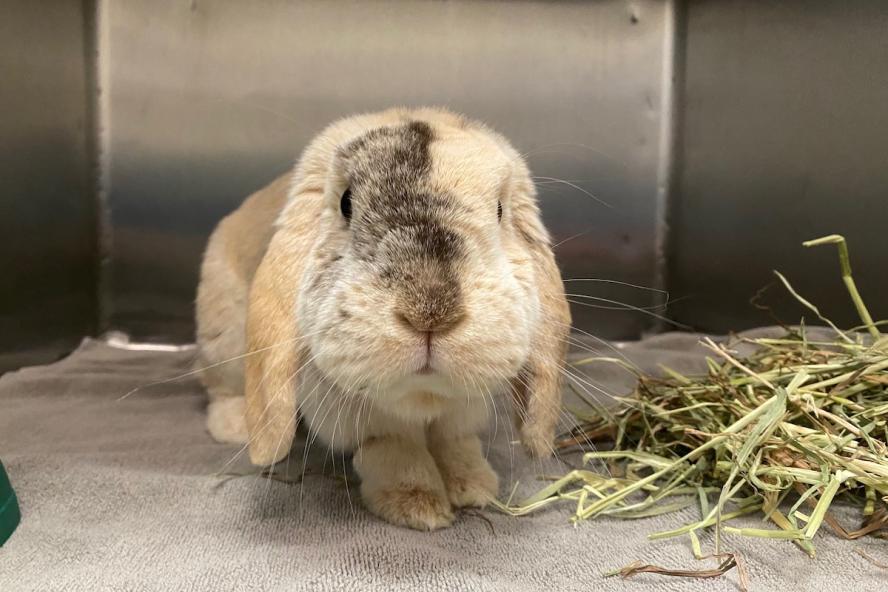After warming up Thumper with a heating pad he was treated for a significant gastric (stomach) obstruction. Dr. Heather Reid, a small animal rotating intern in the ECC, served as the lead. “Dr. Reid was wonderful,” said Mazejka, “… making sure to communicate everything with us and to the team of specialists that would work with Thumper the next morning. She kept him stable through the night.”
Dr. Emily Schlake (she/her), a specialty intern in zoological companion animal medicine service, helped treat Thumper over the following days. “His stomach was really large, distended, and firm on intake, and he was quiet and not responding like rabbits normally do,” said Schlake.
The emergency care team passed an orogastric tube, traversing from the mouth to the stomach, in Thumper. This decompressed his stomach, released air, and enabled the team to extract some hairballs, Schlake explained. “He was blowing his coat (shedding) very badly, with excessive shedding regularly. He must have ingested too much hair, and it caused a blockage.”
Unfortunately, after the first procedure Thumper’s stomach became distended again and obstructed two more times overnight, as the ER team passed an orogastric tube twice more to alleviate the distension. His blood work, specifically glucose and kidney values, were very high and especially concerning.
“He wasn’t perfusing,” said Schlake. “When this occurs in rabbits, the stomach gets so large that it blocks the blood flow to the back half of the body. They get cold, and their kidneys are not getting the blood flow needed for survival.”
The ER team was aggressive overnight with fluid therapy, and although his kidney values had not rebounded by morning, Thumper was no longer obstructed. “His stomach became nice and soft again, so we were dealing with his quiet mental activity because he was so azotemic (characterized by an elevation of waste products in one’s blood) that he felt terrible.”
Schlake spoke with the Mazejkas and told them that although Thumper’s situation was not good, he had a chance. His body needed some time.
Over the next few days, Thumper was treated with antibiotics and hand-fed. His vitals gradually stabilized, and his digestive system regained functionality. He slowly started hopping around. When the Mazejkas visited, they were surprised at how much better and more vibrant he looked. And his kidneys started working again. The next day, Thumper was doing laps around the treatment room and eating without assistance. It was time to go home.
Everything was back to normal when Thumper returned to Foster Hospital for Small Animals a few weeks later for a recheck. “He’s completely back to himself,” said Mazejka. “If anything, he’s even better than when he went in … he’s been so energetic. It was amazing to see how much the hospital staff cared about Thumper. They worked so well together.”
Following this frightening experience, the Mazejka family closely monitors Thumper’s diet and shares grooming responsibilities. According to Schlake, rabbits should be encouraged to eat more hay, as the fibers will help break up the hair pieces they ingest and push small hair pieces into the small intestine, where they will pass through.
Regular grooming and keeping the rabbit’s living space clean to prevent hair buildup is helpful, especially for rabbits that shed frequently.
